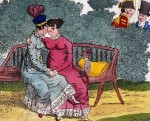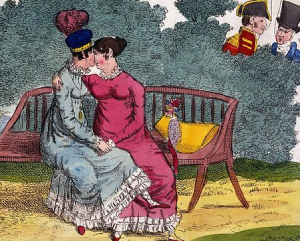
 James Gillray, "Love-à-la-mode, or Two dear friends", XIXth century.Lesbianism is considered in the 17th and nineteenth19th centuries, both as a physical and behavioural pathology.
James Gillray, "Love-à-la-mode, or Two dear friends", XIXth century.Lesbianism is considered in the 17th and nineteenth19th centuries, both as a physical and behavioural pathology.
In the 16th century, an organ hitherto forgotten from the first anatomical treatises reappears in medical writings thanks to the Renaissance and ancient texts: the clitoris. With it develops the fear of autonomous female sexuality, which would not rest on vaginal penetration by a man. This concern is reflected in the figure of the «tribade», which also re-emerges in this period. The tribade is supposed to be a woman with a swollen clitoris up to the size of a small penis that she would use to penetrate other women. If the tribade is found in known medical treatises of the early seventeenth century — such as the Speech on the hermaphrodites, by Jean Riolan published in 1614 — by the end of this century, and especially the 18th century this representation is included in most of the medical speeches. It is, therefore, the Enlightenment that solidifies this confusion between lesbianism and intersexualism, especially in the medical discourses on «hermaphrodites», widely associated with tribades.
This idea of the dangerousness of people whose sexual attributes don’t fit the norm is reflected in everyday life: in the middle of the 18th century, several people are arrested for tribadism and then released after a medical examination that determined that they are physically compliant with binary standards.
This is also the case in many other medical writings that reject the existence of an attraction or sexual intercourse between two women if one of them does not have an enlarged clitoris. Therefore, Barthélémy Saviard, a renowned surgeon of the early 18th century, refuses to believe his patient Marguerite Malaure when she tells him that she had relationships with women», because of the size of her clitoris. For these doctors, sexuality can only be done on a cis heterosexual model of penetration.
However, this is not the case for everyone, and along with this model, there is another pathologization of lesbianism in medical speech, which does not necessarily involve penetration, but rather masturbation. This idea was born in the middle of the eighteenth century with the appearance of anti-masturbation literature, such as the treatise of the physician Samuel Tissot, L’onanism, published in 1760. Lesbianism is then seen as a potentially contagious disease, which is transmitted by masturbation, either individual or mutual. It is then part of a more general dynamic of pathologization of women’s bodies. This idea will develop, especially, in the 19th century, we find several medical treatises that deplore the moral state of places such as prisons, considered a high place of propagation of what is then called “clitorism”, «lesbianism» but also, always “tribadism.”
Indeed, in the 19th century some doctors think that masturbation can be a cause of clitoris growth and the confusion between intersex and lesbian people continue, but in a less and less consensual way than it had been in the 18th century.
Above all, the hygienists point out an idea that had been drafted in the 18th century, but which takes all its strength in the following century: it is mostly the popular classes and mainly the prostitutes who are the cause of this moral pathology. The contagion of lesbianism then takes on its full magnitude and horror and is reflected in literature.
At the end of the 19th century, medical views on lesbians fluctuated between biological (body) and social (behaviour) stigmatization. It is in this context that German theories on homosexuality arrive in France. This word was first used in 1869 by Károly Mária Kertbeny in a German anonymous pamphlet and is part of the nascent movement of sexology. Concepts such as inversion continue to mix gender and sexuality, postulating in the case of lesbians that only women whose gendered characteristics are “reversed” — and therefore considered as male — may be attracted to other women. Similarly, lesbians continue to be considered pathologically, even if the illness is no longer physical but rather mental.
This new medical discipline builds the foundations of homophobia and institutionalized lesbophobia that develop in the 20th century and, that are based on a medicalized vision of these sexualities. The latter is therefore based on a rich history where lesbianism has long been strongly linked to pathology with physical, moral or mental stigmas.
Read more in the dictionary : Clitoris- Hymen
Read the paper in french : Lesbianisme
Références :
Gretchen Schultz, Sapphic fathers: discourses of same-sex desire from nineteenth-century France, Toronto, University of Toronto press, 2015.
Elizabeth Susan Wahl, Invisible Relations: Representations of Female Intimacy in the Age of Enlightenment, Stanford University Press, 1999.
To quote this paper : Anouk Durand-Cavallino, "Lesbianism" in Hervé Guillemain (ed.), DicoPolHiS, Le Mans Université, 2021.